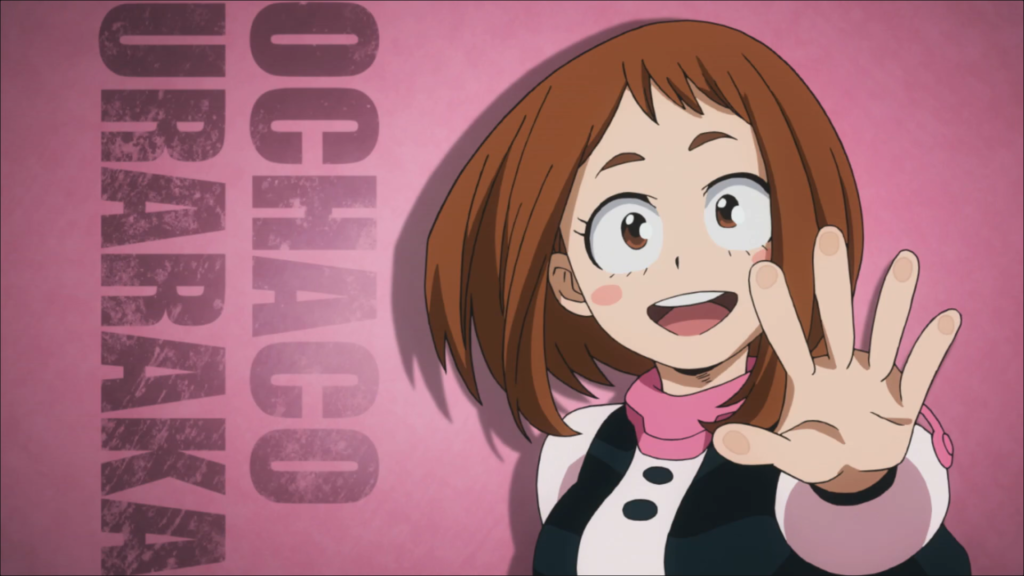One major recurring theme throughout battle shounen manga is authors defining their female characters through their interest in their male counterparts. Their entire life revolves around the boy they’ve fallen in love with, to the point where it’s hard to see them as individuals. Horikoshi Kohei’s Boku no Hero Academia is no different.
Meet Uraraka Ochako. She’s exceptionally peppy with a clear spring to her step, and is often described by her classmates as “bright.” Not so much in the smart way, though, and more in the “I need to look away or I’ll burn my eyes” kind of way. And no, her superhero power is not glowing in the dark, actually, but something much cooler: erasing an object’s gravity through touch. Like her male counterparts Midoriya Izuku and Iida Tenya, she’s attending school in the hopes of becoming a professional superhero one day. But unlike her male counterparts, Horikoshi dedicates hardly any time to her story beyond “so cute” and her massive crush on the main protagonist, Izuku (hero name Deku).
While Ochako rarely talks about her love for Izuku outright, the lengths to which her feelings affect her everyday life are in the extreme. Every teenager struggles in school at some point, and adjusting to a school for superheroes definitely can’t be easy, but failing a test because your lab partner mentioned your crush is outrageous. It’s also easy to say that while in the middle of a life-threatening battle, someone bringing up your crush shouldn’t distract you enough to get stabbed. And yet, both of these are major events in Ochako’s storyline.
Sure, nothing in superhero fiction is ever quite realistic, and humorous exaggerations help to lighten an action-packed narrative. But it feels a little cheap for Ochako to face consequences as high as a final exam failure or hell, an actual freaking stab wound, just because someone brought up her crush for the sake of a joke. This is especially made true when there are other aspects of her character that could easily manifest into academic struggles. Instead, like her male counterparts, we could see her struggle with her superpower a little more in depth.
Seriously, it’s hard to imagine anti-gravity as a combative force. While the story briefly touches on Ochako’s internship with battle hero Gunhead, the detail we get is limited. Even that is pushed to the side in favor of Deku’s struggles in his own internship with the hero Gran Torino. Afterwards, the narrative portrays her as a complete Gunhead Martial Arts Master, and while it’s fun to see her use those moves (when they do make an appearance), it doesn’t seem entirely realistic for the few weeks she spent training. This story is about the process of becoming a hero, and she deserves to have her process celebrated just as much.
With so much focus on her feelings for Deku, we rarely get to see any depth in Ochako’s other relationships. It’s clear that she has plenty, and is often seen hanging out with other members of their class. Other than Deku though, the most detail we see about her personal relationships are with her parents. In the beginning of the story, Ochako explains that her entire motivation for becoming a hero is for the future paycheck that will give her financially struggling parents an easier life. This seems like a fairly important motivation to stick to, and implies a childhood of financial struggle that could easily be extrapolated on.
Unfortunately, her parents are rarely brought up again, despite this character-defining admission. In fact, her motivation very clearly changes later to becoming a hero who will save other heroes… i.e. Deku, go figure. That isn’t necessarily a terrible motivation by any means, but it once again buries all other aspects of her personal life in favor of her romantic interest. And if we are all being honest about high school, boys aren’t the only thing on a girl’s mind. There’s a lot going on! Had Horikoshi allowed her to struggle outside of her crush, we might have seen Ochako’s relationship with her parents fleshed out in further detail: difficult choices between her home and social lives, part-time jobs, struggles with expenses that inevitably come with high school, or perhaps even a particular fight that truly cements in our hearts her dedication to her family.
It’s impossible to talk about Ochako without mentioning her 1v1 fight with the series anti-hero, Bakugou Katsuki. The fight is, without a doubt, spectacular, and truly showcases all the hard work Ochako has put into becoming a true heroine. Of course, we can’t have an Ochako moment that doesn’t involve Deku in some shape or form. Part of her strategy revolves around mimicking Deku’s fighting style: strategic movements rather than sheer force of power. This is one of the few moments we get to see Ochako in all her brilliance. The fight is incredible and her tricky strategy of using Bakugo’s own strength against him is beyond impressive. But… she loses. Sure, Deku also loses his own match to overwhelming power, but we see later successes in major battles with him, while Ochako rarely gets the chance to throw a good punch. It’s disheartening. Had Horikoshi given her more opportunities for a fight as awe-inspiring as this one, the series might have established Ochako as a foil to Deku, however small her actual part in the story. Not only could we see her succeed through her own strength of mind and pure effort, but we could see her character expanded upon through arcs paralleling Deku’s own story.
While Horikoshi tends to hop around from character to character rather than focusing on the development of the main three, it goes without saying that Ochako drew the short straw the minute her visage was put on paper. Both Ochako and Iida get one shining moment as members of the main cast, but Iida’s face-off with the villain Stain far outweighs the narrative weight of Ochako’s brief fight with Bakugou in something as meager as a school sports festival. While Iida’s arc kicks off the beginning of what ultimately leads to our current amalgamation of villains, Ochako’s own moment lies somewhat forgotten underneath a metaphorical pile of love letters addressed to our dear protagonist. Were she given the same attention and care that her male counterparts were given, it goes without saying that Ochako’s brilliant light would be able to shine far, far brighter.
Featured image source: My Hero Academia anime; interior images via Horikoshi Kohei’s Boku no Hero Academia / My Hero Academia manga.

